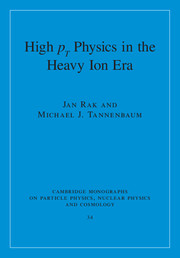Book contents
- Frontmatter
- Contents
- Preface
- 1 Introduction and overview
- 2 Basic observables
- 3 Some experimental techniques
- 4 The search for structure
- 5 Origins of high pT physics – the search for the W boson
- 6 Discovery of hard scattering in p-p collisions
- 7 Direct single lepton production and the discovery of charm
- 8 J/Ψ, ϒ and Drell–Yan pair production
- 9 Two particle correlations
- 10 Direct photon production
- 11 The search for jets
- 12 QCD in hard scattering
- 13 Heavy ion physics in the high pT era
- 14 RHIC and LHC
- Appendix A Probability and statistics
- Appendix B Methods of Monte Carlo calculations
- Appendix C TAB and the Glauber Monte Carlo calculation
- Appendix D Fits including systematic errors
- Appendix E The shape of the XE distribution triggered by a jet fragment, for example, π0
- Appendix F kT phenomenology and Gaussian smearing
- References
- Index
Appendix D - Fits including systematic errors
Published online by Cambridge University Press: 05 May 2013
- Frontmatter
- Contents
- Preface
- 1 Introduction and overview
- 2 Basic observables
- 3 Some experimental techniques
- 4 The search for structure
- 5 Origins of high pT physics – the search for the W boson
- 6 Discovery of hard scattering in p-p collisions
- 7 Direct single lepton production and the discovery of charm
- 8 J/Ψ, ϒ and Drell–Yan pair production
- 9 Two particle correlations
- 10 Direct photon production
- 11 The search for jets
- 12 QCD in hard scattering
- 13 Heavy ion physics in the high pT era
- 14 RHIC and LHC
- Appendix A Probability and statistics
- Appendix B Methods of Monte Carlo calculations
- Appendix C TAB and the Glauber Monte Carlo calculation
- Appendix D Fits including systematic errors
- Appendix E The shape of the XE distribution triggered by a jet fragment, for example, π0
- Appendix F kT phenomenology and Gaussian smearing
- References
- Index
Summary
The maximum likelihood method and least squares fits
The likelihood function L is defined as the a priori probability of a given outcome. Since Gaussian probability distributions are common (as a consequence of the central limit theorem) and since there is also an important theorem regarding likelihood ratios for composite hypotheses, it is convenient to use the logarithm of the likelihood, W = -2 ln L.
There are generally two types of fits used for data from experiments. (i) The standard maximum likelihood method is to fit a function to n independent trials of the same distribution, for example the muon lifetime measured from the decay times ti of individual decays. (ii) The method of least squares is also an extremum method which performs Gaussian least squares fits for binned data from histograms to predictions of the expectation values at each data point, which may be functions of parameters to be determined. This will be discussed following a review of the standard maximum likelihood method and the likelihood ratio test.
Maximum likelihood fit to a Gaussian, an instructive example
A nice example of the standard maximum likelihood method is a fit to a Gaussian with mean μ and variance σ2 from the observation of n independent trials with values xi from this distribution, in other words a sample of n trials from this population.
- Type
- Chapter
- Information
- High-pT Physics in the Heavy Ion Era , pp. 336 - 347Publisher: Cambridge University PressPrint publication year: 2013

